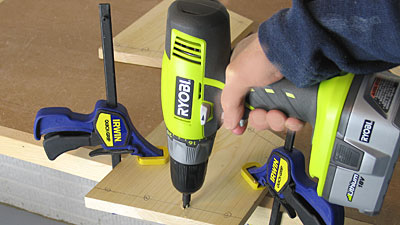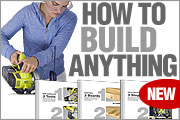

Ryobi Cordless Drill - 18v Lithium-IonComing in a close second to the Ryobi circular saw, a power drill is my next must-have tool for building anything from wood. It’s funny though, that most of what I do with a drill has nothing to do with drilling. More often I’m driving screws, not drilling holes. Of course, this is where the confusion starts…trying to figure out the difference between drilling and driving. Both are very different kinds of tasks for a tool, and that’s why drills today have all those knobs and adjustments that I never seem to figure out. Hopefully they will make a little more sense after a closer look at what you can and can’t do with a power drill.
What You Can Do with a Cordless DrillWhen I bought my new Ryobi cordless drill a couple weeks ago, I didn't’ think I’d need instructions to figure it out…just twist the drill chuck open, slip in a drill bit, twist the drill chuck closed, and I’d be ready to go. Never mind about all the numbers, knobs, and switches spread out all around drill. I’d get those figured out eventually. But halfway into my first drill hole I knew something wasn’t quite right. The drill bit just stopped turning. The motor was still going, but it was making a weird clacking sound. So like I usually do when things go wrong, I started fiddling with whatever looked like an adjustment. Sure enough, I stopped the clacking sound by twisting something behind the chuck a few turns clockwise. There are numbers listed around the chuck, and the bigger number I turned to, the less clacking I heard from the motor. That worked. But it didn’t really help me understand what the settings were for. I was able to drill the hole I needed, but I could pretty much figure that I wasn’t getting the full potential of what this tool could do. Everything became a little more clear after I skimmed through the instruction manual. This is where I finally learned the difference between drilling holes and driving screws, and which settings on the drill go with which. Drilling HolesLet’s start with the more simple task, drilling. This is an easy setting. Somewhere on the top of the drill should be a switch for setting the drill speed. You only have two choices here…low-speed or hi-speed. We’re talking about drilling holes right now, so I need to set this to hi-speed. Why? If I’m drilling holes I want my drill bit to turn a whole lot faster than it would simply driving screws. Sure, the drill will sort of work okay at either setting, but keep in mind that drill bits can clog up fast with wood. If you drill holes at low-speed, the bit will fill up with wood and just not work that great. So the higher speed for drilling holes just makes sense. But wait, one more setting to go. Remember the clacking sound I talked about? That was the drill clutch in action. That meant that I had the drill set up for driving screws, not drilling holes. More about that problem later.
For now, look for a set of numbers along a twistable ring at the back of the chuck. If you keep turning towards the larger numbers, eventually you’ll run out of numbers and finally reach a mark that sort of looks like the end of a drill bit. That’s the setting for drilling holes…not screws…and without getting clacking sounds from the motor. Driving Screws The real sophistication in power drills is their ability to drive screws. As I mentioned earlier, driving screws is a bit different of a task for a power drill than simply drilling holes. Wood screws can be somewhat tricky…and cause lots of problems if you don’t have your drill set up the right way. Using the clutch to avoid stripped heads Before power drills, I think we just let the feel of the screwdriver tell us when to stop. That was easy. Not so easy with an 18-volt power drill that weighs eight pounds. It just doesn’t take much to totally destroy a soft-headed woodscrew in a matter of seconds. Enter the adjustable clutch! This is a great feature that keeps your drill from drilling too hard. Look for an adjustable ring somewhere behind the clutch that starts at 0 and goes up to something like 20 or 25. Zero means you’re at the softest setting…and 25 is your drill totally unleashed. If you have soft-metal woodscrews (like brass) that can easily get stripped out, you need to harness some of your drill’s power before you start driving. Start out at zero and slowly move up in numbers till you have just right amount of torque to drive the screw without stripping. This is all trial and error, so the numbers themselves don’t really mean anything. Of course, for all this to work right, you first need to have the right sized hole and a wood screw to match. This is probably the number one reason that screws get stripped out in the first place, but that’s another topic I’ll cover a little later. For now, just know that the drill clutch is for driving screws, not for drilling holes. Using the clutch to avoid buried wood screwsJust as much a problem as screws not going in far enough, are screws that go too far. This can cause more problems than you think, because the damage stays somewhat hidden from view. Be assured that when you see a screw head start to disappear into wood, you’re headed for trouble. The clutch adjustment on a power drill can keep screws from going too far into the wood. If you can get your drill holes and screw sizes matched up the way they should be matched, the clutch on a drill does a nice job of knowing exactly when to stop driving the screw. This is all trial and error (again), but once you get the hang of how the Ryobi cordless drill works, you’ll never go back. |

3 Tools, 3 Boards, 3 Steps
|
|